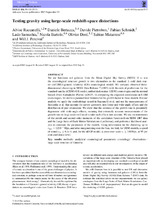| dc.contributor.author | Raccanelli, Alvise | |
| dc.contributor.author | Bertacca, Daniele | |
| dc.contributor.author | Pietrobon, Davide | |
| dc.contributor.author | Schmidt, Fabian | |
| dc.contributor.author | Samushia, Lado | |
| dc.contributor.author | Bartolo, Nicola | |
| dc.contributor.author | Doré, Olivier | |
| dc.contributor.author | Matarrese, Sabino | |
| dc.contributor.author | Percival, Will J. | |
| dc.date.accessioned | 2017-07-25T09:11:57Z | |
| dc.date.available | 2017-07-25T09:11:57Z | |
| dc.date.issued | 2013 | |
| dc.identifier.citation | Raccanelli, A. et al. (2013). Testing gravity using large-scale redshift-space distortions. Monthly Notices of the Royal Astronomical Society, 436: 89–100 | en_US |
| dc.identifier.issn | 0035-8711 | |
| dc.identifier.uri | http://hdl.handle.net/10566/3104 | |
| dc.description.abstract | We use luminous red galaxies from the Sloan Digital Sky Survey (SDSS) II to test
the cosmological structure growth in two alternatives to the standard cold dark matter
( CDM)+general relativity (GR) cosmological model. We compare observed threedimensional
clustering in SDSS Data Release 7 (DR7) with theoretical predictions for the
standard vanilla CDM+GR model, unified dark matter (UDM) cosmologies and the normal
branch Dvali–Gabadadze–Porrati (nDGP). In computing the expected correlations in UDM
cosmologies, we derive a parametrized formula for the growth factor in these models. For our
analysis we apply the methodology tested in Raccanelli et al. and use the measurements of
Samushia et al. that account for survey geometry, non-linear and wide-angle effects and the
distribution of pair orientation. We show that the estimate of the growth rate is potentially
degenerate with wide-angle effects, meaning that extremely accurate measurements of the
growth rate on large scales will need to take such effects into account. We use measurements
of the zeroth and second-order moments of the correlation function from SDSS DR7 data
and the Large Suite of Dark Matter Simulations (LasDamas), and perform a likelihood analysis
to constrain the parameters of the models. Using information on the clustering up to
rmax = 120 h−1 Mpc, and after marginalizing over the bias, we find, for UDM models, a speed
of sound c∞ ≤ 6.1e-4, and, for the nDGP model, a cross-over scale rc ≥ 340 Mpc, at 95 per
cent confidence level. | en_US |
| dc.language.iso | en | en_US |
| dc.publisher | Oxford University Press | en_US |
| dc.rights | Publisher retains copyright. Authors may archive the published version in their institutional repository. | |
| dc.source.uri | http://dx.doi.org/10.1093/mnras/stt1517 | |
| dc.subject | Methods | en_US |
| dc.subject | Analytical – cosmological | en_US |
| dc.subject | Parameters – cosmology | en_US |
| dc.subject | Observations | en_US |
| dc.subject | Large-scale structure of Universe | en_US |
| dc.title | Testing gravity using large-scale redshift-space distortions | en_US |
| dc.type | Article | en_US |
| dc.description.accreditation | Department of HE and Training approved list | |

